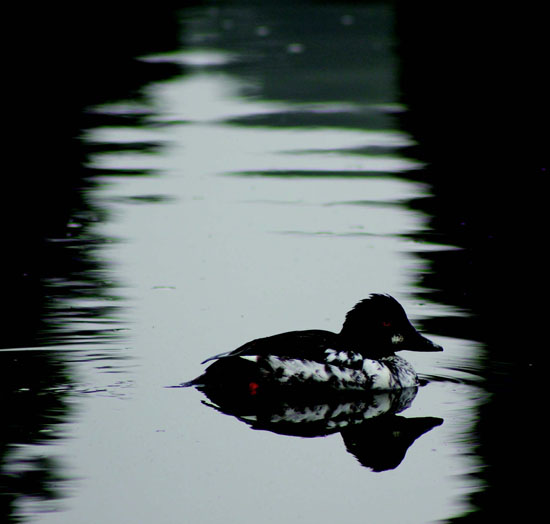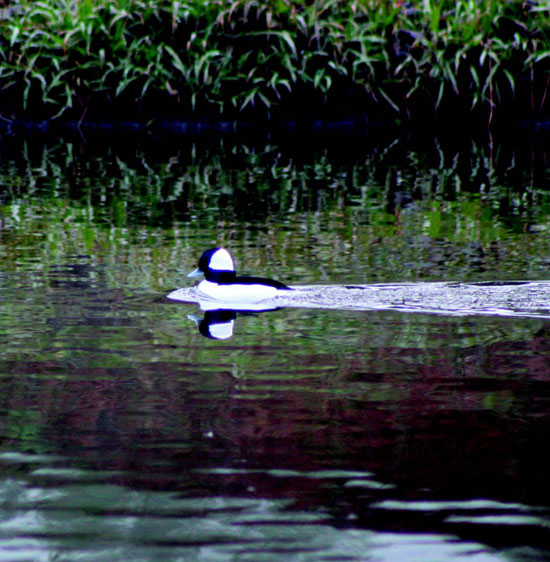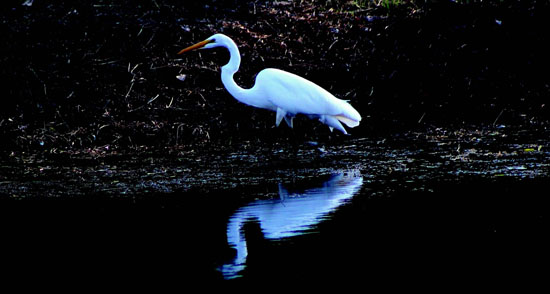|
|
Published January 13, 2016
|
Fancy Hats Are For the Birds
|
| Winter bird watching in Lamorinda |
| By Chris Lavin |
 |
| A colorful male Hooded Merganser duck and three females head upwind in search of small fry at the golf course in Moraga. Photo Chris Lavin |
It used to be, about 100 years ago, that the great egret in the Lamorinda area was targeted for shooting. Its plumage, especially in particular its wide-spreading tail that opens into a magnificent fan (in breeding season, which starts here soon) meant that hanging out at the area around the Moraga Creek and golf course, the Lafayette Reservoir, the San Pablo Reservoir in Orinda, and elsewhere, made for ripe plumage, and curtains for the bird, which got shot and plucked. Fancy hats awaited as far off as New York.
 "It turned out that it was almost an extinction," said Cindy Margulis, the executive director of the Golden Gate Audubon Society, about the birds' plight. "Their entire line could have died out."
"It turned out that it was almost an extinction," said Cindy Margulis, the executive director of the Golden Gate Audubon Society, about the birds' plight. "Their entire line could have died out."
 Thanks in part to federal legislation that outlawed its slaughter, the egret has survived, and is thriving now throughout Lamorinda. Its smaller cousin, the snowy egret, seems to be doing well, too, Margulis said. "Egrets are fascinating because they are designated as a migratory bird, but they don't always migrate," she said. "That's the case a lot around here." She said that global warming is keeping more birds around the area that would usually fly south for the winter.
Thanks in part to federal legislation that outlawed its slaughter, the egret has survived, and is thriving now throughout Lamorinda. Its smaller cousin, the snowy egret, seems to be doing well, too, Margulis said. "Egrets are fascinating because they are designated as a migratory bird, but they don't always migrate," she said. "That's the case a lot around here." She said that global warming is keeping more birds around the area that would usually fly south for the winter.
 So while the springtime cacophony of songbirds might be silent in these darkest of days, there are still a lot of interesting birds to watch in the wintertime.
So while the springtime cacophony of songbirds might be silent in these darkest of days, there are still a lot of interesting birds to watch in the wintertime.
 "There's not a whole lot to see right now," said Bill Swearingen, a master falconer who lives in Bollinger Canyon and has a propensity for merlin falcons. "But on the water you can still see a lot of birds. And offshore you're still seeing some merlins once in a while, the ones who aren't migrating. And you can still see ospreys, golden eagles and bald eagles, too."
"There's not a whole lot to see right now," said Bill Swearingen, a master falconer who lives in Bollinger Canyon and has a propensity for merlin falcons. "But on the water you can still see a lot of birds. And offshore you're still seeing some merlins once in a while, the ones who aren't migrating. And you can still see ospreys, golden eagles and bald eagles, too."
 But sit in one spot long enough, and you will hear and see birds, Margulis said. "We have 300 to 400 species just in this area," she said, including five species of grebes "and bunches of ducks." So get out the binoculars, she advises, and start sitting still.
But sit in one spot long enough, and you will hear and see birds, Margulis said. "We have 300 to 400 species just in this area," she said, including five species of grebes "and bunches of ducks." So get out the binoculars, she advises, and start sitting still.
 The Audubon Society offers local beginning and advanced bird-watching classes, starting now. For a list of classes visit www.goldengateaudubon.org.
The Audubon Society offers local beginning and advanced bird-watching classes, starting now. For a list of classes visit www.goldengateaudubon.org.

|
 |
| A sub-adult male Goldeneye takes a swim. Photos Chris Lavin |
 |
| Buffleheads disappear in an instant, diving underwater in search of snacks, and then popping up again. If you're with kids, you can make a game out of guessing how long it will take for the bird to resurface. |
 |
| Many great egrets have ended up sticking around in the Lamorinda area in recent years, preferring to stay put rather than migrate. The birds' feathers used to be highly valued for women's hats, which almost wiped out the entire species. A federal regulation called a stop to shooting them; now global warming is keeping them put. |
|
|
| |
|
|
|
|







